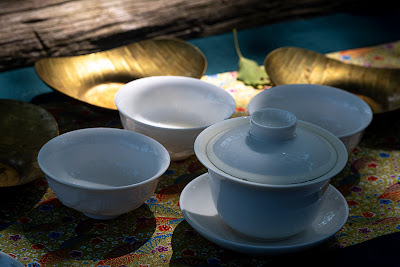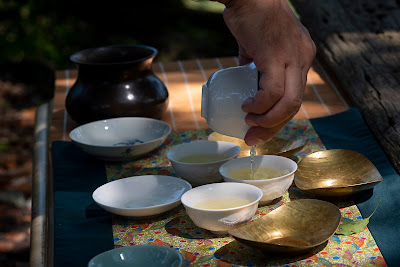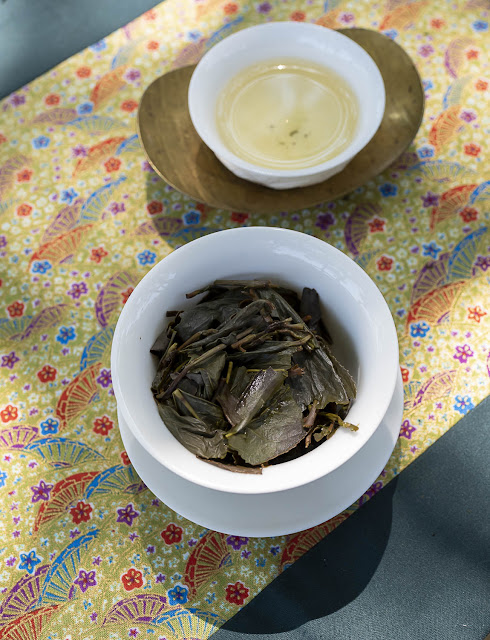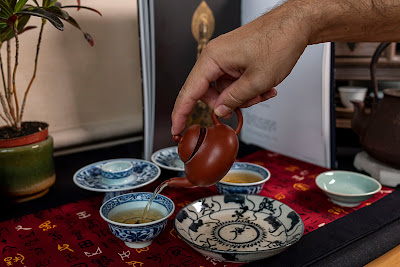Fêtons la rentrée littéraire!
Cette semaine, j'ai le plaisir de partager avec vous un entretien sur le thé avec
Olivier F Delasalle, un écrivain philosophe! Cet entretien a deux parties indépendantes l'une de l'autre. Dans
la première partie, je pose des questions sur le thé et Olivier F Delasalle nous parle de son rapport avec ce breuvage, ses souvenirs, comment cela a évolué, l'importance des saisons... Dans
la seconde partie, il nous fait la démonstration d'une infusion d'un Oolong Beauté Orientale avec un gaiwan et, après l'avoir vu à l'
œuvre, je lui donne des conseils pour améliorer sa technique.
Je vous recommande de lire les textes hebdomadaires qu'Olivier F Delasalle publie sur son site. Il a une manière claire, détaillée et intelligible d'expliquer des concepts philosophiques. Certains penseurs s'amusent souvent à complexifier leur pensée pour paraitre plus doué et cultivé et vous faire sentir votre ignorance. Olivier F Delasalle n'hésite pas à nous prendre par la main pour nous mener sur le chemin le moins sinueux jusqu'au sommet de la pensée! Dans mon dernier article sur
le bonheur du thé, je me suis inspiré d'un de ses textes récents
pour une approche hébraïque de Confucius et d'un autre sur
Mary Poppins, le secret de la légereté!
Je lui dois aussi de m'être plongé dans la lecture de la Recherche du Temps Perdu de Marcel Proust! C'est donc grâce à lui aussi que j'ai entrepris ce travail d'analyse de l'emploi du mot 'thé dans cette
œuvre! Or, cela tombe bien, je viens d'achever la lecture de 'Le Côté de Guermantes' au format Folio Classique, le troisième volume de la Recherche. Après
Du Côté de chez Swann et
A l'Ombre des Jeunes Filles en Fleur, voici toutes les mentions de ce mot dans cet ouvrage.
Remarquons que le nombre de mentions continue de baisser: 16 alors que chaque nouveau livre en a 200 plus que le précédent! Selon moi, cela montre que Proust fait attention à se renouveler et à ne pas trop se répéter. Cela explique le plaisir qu'on peut avoir à le lire. Malgré la longueur des phrases et des livres, chaque page exprime des idées nouvelles, des sentiments inattendus, des traits d'humour et des observations sans concessions.
Page 108.
"Mais on lui avait raconté que parfois, quand il y avait à Paris un spectacle qu'elle jugeait intéressant, Mme de Guermantes faisait atteler une de ses voitures aussitôt qu'elle avait pris le thé avec les chasseurs et, au soleil couchant, partait au grand trot, à travers la forêt crépusculaire, puis par la route, prendre le train à Combray pour être à Paris le soir."
Commentaire: Le thé comme rendez-vous social est tellement sacré que Mme Guermantes n'entreprend son voyage décidé sur un coup de tête qu'après la fin du thé!
Page 283
"Car on était poli, monsieur, dans ce temps-là, et un maitresse de maison n'aurait pas su se contenter d'envoyer sa carte en ajoutant à la main :"une tasse de thé", ou "thé dansant", ou "thé musical"."
Commentaire: Envoyer ou laisser sa carte (de visite) était une manière d'inviter quelqu'un simplement, sans écrire une lettre. Remarquons que le thé est alors le prétexte à trois types de rencontres: 'la tasse de thé", une rencontre aucours de laquelle du thé est servi, le 'thé dansant' est un bal et le 'thé musical' est un concert. L'ajout de thé pour dansant et musical permet de rendre l'événement plus distingué et raffiné.
Page 291
"Elle se leva en posant ses pinceaux près de ses fleurs, et le petit tablier qui apparut alors à sa taille et qu'elle portait pour ne pas se salir avec ses couleurs, ajoutait encore à l'impression presque d'une campagnarde que donnaient son bonnet et ses grosses lunettes et contrastait avec le luxe de sa domesticité, du maitre d'hôtel qui avait apporté le thé et les gâteaux, du valet de pied en livrée qu'elle sonna pour éclairer le portrait de la duchesse de Montmorency, abbesse dans un des plus célèbres chapitres de l'Est.
Commentaire: Ce passage souligne clairement à quel point le thé est le symbole du luxe de cette époque.
Page 297
"- Assieds-toi, on va prendre un peu de thé, dit Mme de Villeparisis à Mme de Guermantes, sers-toi toi-même, toi tu n'as pas besoin de voir les portraits de tes arrière-grand-mères, tu les connais aussi bien que moi."
Commentaire: Le fait qu'elle précise que Mme de Villeparisis se serve elle-même montre que d'habitude ces nobles se font servir le thé par des domestiques.
Page 299
"Peut-être eussé-je été un peu moins ému si je l'eusse rencontrée chez Mme Villeparisis à une soirée, au lieu de la voir ainsi à un des "jours" de la marquise, à un de ces thés qui ne sont pour les femmes qu'une courte halte au milieu de leur sortie et où gardant le chapeau avec lequel elles viennent de faire leurs courses elles apportent dans l'enfilade des salons la qualité de l'air du dehors et donnent plus jour sur Paris à la fin de l'après-midi que ne font les hautes fenêtres ouvertes dans lesquelles on entend les roulements des victorias : Mme de Guermantes était coiffée d'un canotier fleuri de bleuets ;"
Commentaire: Dans cette phrase, on apprend que les 'thés', ces rencontres mondaines de l'après-midi suivaient un rythme hebdomadaire et que les personalités avaient chacune un jour en particulier où elles recevaient.
Page 321
"Je crois que vous vouliez lui parler de l'affaire Dreyfus", ajouta-t-elle sans plus se préoccuper si cela faisait plaisir à M. de Norpois qu'elle n'eût pensé à demander leur agrément au portrait de la duchesse de Montmorency avant de le faire éclairer pour l'historien, ou au thé avant d'en offrir une tasse."
Commentaire: Dans ce livre, Proust montre combien l'affaire Dreyfus a passionné le tout Paris de son époque. Mais Mme de Guermantes, dont il s'agit ici, sait garder une hauteur olympienne, et cette affaire ne la trouble pas le moins du monde.
Page 323
"Promenant sur le grand nombre de personnes qui entouraient la table à thé les regards affables, malicieux et un peu éblouis par les rayons du soleil couchant, de ses petites prunelles rondes et exactement logées dans l'œil comme les "mouches" que savait viser et atteindre si parfaitement l'excellent tireur qu'il était, le duc s'avançait avec une lenteur émerveillée et prudente, comme si, intimidé par une si brillante assemblée, il eût craint de marcher sur les robes et de déranger les conversations."
Commentaire: La table à thé est donc bien le lieu où les invités se réunissent lors du 'thé', ce rendez-vous de la haute société.
Page 374
""Vous ne voulez pas que je vous donne une tasse de thé ou un peu de tarte, elle est très bonne", me dit Mme de Guermantes, désireuse d'avoir été aussi aimable que possible."
Commentaire: Plus tard, le narrateur expliquera que les nobles de vielle lignée sont pleins d'amabilités pour des jeunes bourgeois comme lui, car ils sont tellement certains de leur supériorité que s'abaisser à rendre de petits services ne fait que rehausser leur prestige et l'idée qu'ils se font d'eux-même!
Page 600
" Le même génie de la famille présentait à Mme de Guermantes la situation des duchesses, du moins des premières d'entre elles et comme elle multimillionnaires, le sacrifice à d'ennuyeux thés, diners en ville, raouts, d'heures où elle eût pu lire des choses intéressantes, comme des nécessités désagréables analogues à la pluie, et que Mme de Guermantes acceptait en exerçant sur elles sa verve frondeuse, mais sans aller jusqu'à rechercher les raisons de son acceptation."
Commentaire: Recevoir des gens de condition inférieure est vu comme un sacerdoce, un devoir qu'on accomplit à cause de son rang élevé. Cette notion de service, on l'a encore retrouvé chez la reine Elizabeth II et sa mort est aussi celle de cet esprit aristocratique qui anima ses réceptions.
Page 621
"Et elle avait beau retenir les mots d'Oriane, imiter ses robes, servir à ses thés les mêmes tartes aux fraises, il y avait des fois où elle restait seule toute la journée avec une dame d'honneur et un conseiller de légation étranger/"
Commentaire: Les gens préfèrent toujours l'original à la copie!
Page 629
"Non, mon petit", disait-il à la vicomtesse d'Egremont, que Mme de Guermantes ne pouvait souffrir mais qui, ne bougeant pas de chez la princesse d'Epinay où elle s'abaissait volontairement à un rôle de soubrette (quitte à battre la sienne en rentrant), restait, confuse, éplorée, mais restait quand le couple ducal était là, débarrassait des manteaux, tâchait de se rendre utile, par discrétion offrait de passer dans la pièce voisine, "ne faites pas de thé pour nous, causons tranquillement, nous sommes des gens simples, à la bonne franquette."
Commentaire: On reste sur le thème du thé comme luxe: ici, l'absence de thé signifie donc qu'on est 'simple' et qu'on discute 'tranquillement', sans essayer de faire des mots d'esprit!
Page 647
"L'idée qu'on pouvait volontairement renoncer à cent diners ou déjeuners en ville, au double de "thés", au triple de soirées, aux plus brillants lundis de l'Opéra et mardis des Français pour aller visiter les fjords de la Norvège ne parut pas aux Courvoisier plus explicable que Vingt mille lieues sous les mers, mais leur communiqua la même sensation d'indépendance et de charme."
Commentaire: "thés" entre guillemets signifie donc les réunions de l'après-midi entre gens de qualité autour d'une tasse de thé et non la tasse de thé.
Page 666
"Et avoir avec cela un valet de pied qui est amoureux d'une petite grue et qui fait des têtes si je ne demande pas à cette jeune personne de quitter un instant son fructueux trottoir pour venir prendre le thé avec moi!"
Commentaire: Exemple d'humour!
Page 696
"Quelquefois, quand cela nous embêtait trop d'aller à un thé ou à une matiné, nous partions pour la campagne et il me montrait des mariages extraordinaires de fleurs, ce qui est beaucoup plus amusant que les mariages de gens, et a lieu d'ailleurs sans lunch et sans sacristie."
Commentaire: Aller voir des fleurs au lieu d'aller à un thé, voilà comment on était rebelle, avec classe, dans la société parisienne du début du XXe siècle!

















































